My friend Sarah and I just returned today from six full days of research at the Family History Library in Salt Lake City. We spent six months preparing for these six days, so we thought it would be most appropriate if we presented our top six tips for your next visit to the library. There are many sites on the web that offer incredible tips for preparing and visiting the library. These are things we learned upon our arrival and through trial and error.
When you’re done reading these tips, check out all of our photos from the Family History Library on Flickr.
We’ve also posted short videos showing the main areas for:
#1: Dry erase magnets are awesome.
Many sites recommend you to bring magnets to quickly refile microfilms. We didn’t see a single patron doing this except for us, and it was such a huge time saver! We picked up these Quartet ReWritables Dry-Erase Magnet Boards prior to our trip and found them to be an amazing way to retrieve and refile microfilm in the stacks. You can pick these up on Amazon.com or in stores at Wal-Mart. Simply determine which film you need, and write the film number on the magnet. Take it into the stacks and retrieve your film. Place the magnet on the outside of the cabinet. When you’re done with the film, easily locate the cabinet by finding your magnet. Erase the film number, and start over again! Cheap, effective and fast.
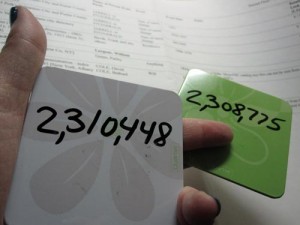
Dry Erase Magnets
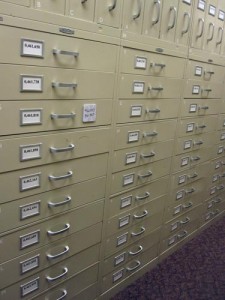
Use Dry Erase Magnets to quickly refile microfilms
#2: Slashes come after numbers.
It took the help of a couple of volunteers at the library for us to figure this one out. The FHL uses a modified Dewey Decimal system. It follows the pattern of numbers coming after letters, for example: “977.4 A5b” comes before “977.4 4a” in the stacks. What we also discovered is that slashes come after numbers. For example: “974.522 H2b” comes before “977.522/A9c” in the stacks. Pay attention to the slashes and make sure you are looking at the section following the last number.
We’d also like to note that books can be found in the stacks, in Overflow or in an area called High Density. Overflow stacks are located at the end of the main stacks in an area called “Q.” However, High Density books are not accessible to patrons and are not always noted in the catalog. If you can’t find the book you need, ask at the Access Services window. If it’s in High Density, you may need to visit another floor and ask them to retrieve it for you. When this occurs, be prepared to hand over your government ID until you return the book to Access Services.

Big Stack of Books
#3: Vault film requests are filed with everything else.
If you’ve requested vault films (and we hope you do ahead of time) note that they will be filed in with the rest of the microfilms. You don’t need to ask for them at Access Services. They simply show up. If they aren’t filed in with the rest, they may not have had enough room for your film, so look in the microfilm Overflow section which will be in the last row among the cabinets labeled “Empty.” Look for the Overflow tag attached to a cabinet in that last row.
#4: You don’t need a copy card to scan. Scanning is free!
You can scan books or microfilms and it is completely free.
Scanning with Multifunction Machines
Scanning books can be done on any multifunction machine located on any floor. Simply pick up the attached copy card (on a cord) and swipe it to begin. Follow the instructions on the top of the machine to insert your flash drive and scan the document. Note that books scanned in this fashion allow you to scan multiple pages at once, but all scans from your session are embedded into a single PDF file. If you are scanning different books, you may wish to end your session and begin a new one after each book so that it creates multiple PDF files. We found the multifunction scanners to be fast, but we had no idea if the results on the flash drive were what we were expecting. There is no feedback to the user with this method.
Here’s an example of a document I scanned which the machine descriptively named 20120620202819789.pdf. I had no way of knowing it was sideways or that it was cut off on one side until I looked at it on the computer.

Multifunction Machine - Scan, Copy or Print

Multifunction Machine - Copy card reader and USB drive port
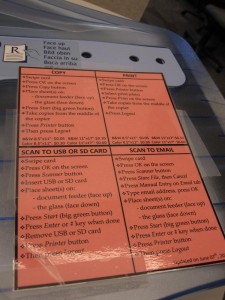
Multifunction Machine - Instructions
Scanning with the Flatbed Scanner
You can add your name to the list at the Access Services window on the third floor for a 15-minute time slot on the flatbed scanner. While it affords better feedback to the user and allows you to determine exactly what you are scanning and the file name you are saving it as, the scanner is painfully slow. I found it much more effective to simply take photographs of the book title page and the pages I wanted to keep with my camera. The readability is the same when using macro mode and a steady hand.
Scanning with the Microfilm Scanners
Most floors have microfilm scanners. These machines are fast and easy to use, and volunteers are abundant and ready to assist you with the technology. Simply insert your flash drive and click on the button that shows a scanner with a USB stick (duh!) and you can choose what to call your file and where you want to save it. Make sure you are saving the file to your flash drive and not to the hard drive. The application keeps the previous user’s settings so always watch out for that. Also, I recommend saving in both .TIF and .JPG for the best results. The .TIF file will allow you to change exposure and contrast later with no compression loss, while a .JPG copy will be fast for sharing and posting online. It only takes a second to save it twice. Bonus tip – Use a label maker to adhere your name and cell phone number onto each flash drive you use. If you forget the flash drive in a computer somewhere, some nice soul might contact you to return it.
Note that you can’t use the microfilm scanners for long periods of time. The library expects you to find the location on the microfilms using the old fashioned hand crank readers, and then transfer your film to the scanner to scan what you’d like. Ask the volunteers for assistance if you need some help with the setup or the application.
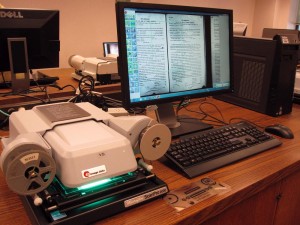
Microfilm Scanner
Printing Documents
Printing is not free. You need you purchase a copy card to print. Regular 8.5×11 black and white prints cost $0.05 each. Bonus tip – when you print to the print server from any computer, it asks you to enter your initials and an identifier so you know which document you are printing. One of the volunteers mentioned to me that it is advantageous to add extra spaces in front of your identifier because spaces show up at the top of the list. For example, “  My File” will show up before “My File” in the list of everyone’s print jobs. It’s a sneaky way to make sure your prints show up at the top of the list when you print your files.

Copy Cards Vending Machine
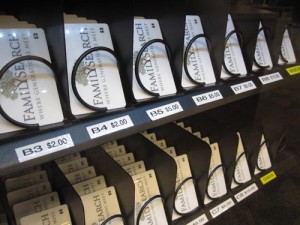
Copy Cards for Sale - $2 and up
#5: There is no caffeine in the building.
Caffeine is a stimulator and an addictive substance, something that the Mormon culture does not support. You will not find any caffeine in the break room. No coffee; no Coke or Pepsi. They do have non-caffeinated beverages such as milk, chocolate milk, juice, Caffeine Free Diet Coke, Sprite, Cactus Cooler and the like. If you want a caffeine fix we recommend heading either to JB’s Restaurant for a break, or go to the gift shop or onto one of the floors in the Plaza Hotel next door where they have Coke products in the vending machines.

Vending Machines - Sodas

Vending Machines - Milk, Water and Juice
#6: Ask, and then ask again. And then ask again. And again, if you need to.
We cannot stress this last tip enough. We read this on a few sites during our preparation for the trip, but I’m going to tell you my story so it sinks in for you!
I’ve got a brick wall on my mother’s side. Her father’s father came to the USA around 1891 from “Germany.” That’s all I know.
- I approached a volunteer and I asked her if she knew of any resources to search immigration or ship records from Germany which were not already online. She pointed me to FamilySearch.org and said to use the computers to look up what I needed. Not helpful.
- The second time I went to a different staff member, and asked him if he knew of any Naturalization records available that might help me with my brick wall. He said usually the library doesn’t keep Naturalization records because the NARA sites want to charge for them. (Not true – they have all of them on microfilm onsite for the county I needed.) He showed me as he navigated on his computer to the place in the catalog for Naturalization records for Otsego County, Michigan. Then he clicked on the film number and was presented with the screen to “order” the film to your local FHL center. He proceeded to explain to me that this was how I could “order” the Naturalization record from the National Archives. OMG. We’re going backwards here.
- As a final last ditch attempt, on the International floor I approached a woman near the Maps area. I asked her if she could point me to any maps of Poland while it was under German occupation. As it turned out, she was a professional genealogist. She proceeded to dig deeper and deeper into my story and worked with me for more than an HOUR one-on-one, giving me one lead after the next. She poured over the documents that I had such as the Naturalization papers, obituaries and census records, and allowed me to take notes on more than a dozen ways I might be able to get the information I need. The experience was incredible! She was incredible. I am so glad I asked her where to find a map of Poland.
The people at the Family History Library are a mix of staff, volunteers and professional genealogists. There is no way of knowing who is whom by just looking at them. You might approach one person and he is a volunteer missionary, and the woman sitting next to him might be a professional genealogist. It pays to keep asking until you get the help you need. Ask questions in different ways. Ask different people. Ask at different times or on different days. You never know where it might lead you.
We hope these tips help you during your experience at the Family History Center. Remember to take lots of breaks, and get out there to see the sights in Salt Lake City. The area is beautiful and has plenty of fun to offer.
Happy Researching!
Jessica
www.jessicagreen.com